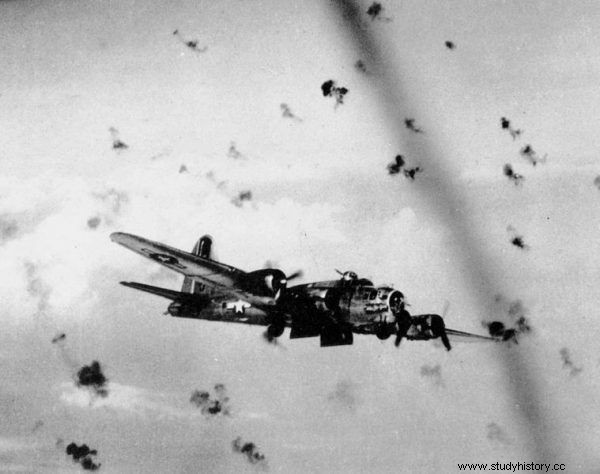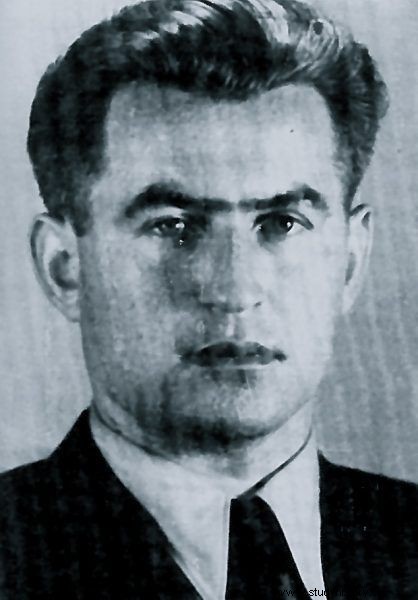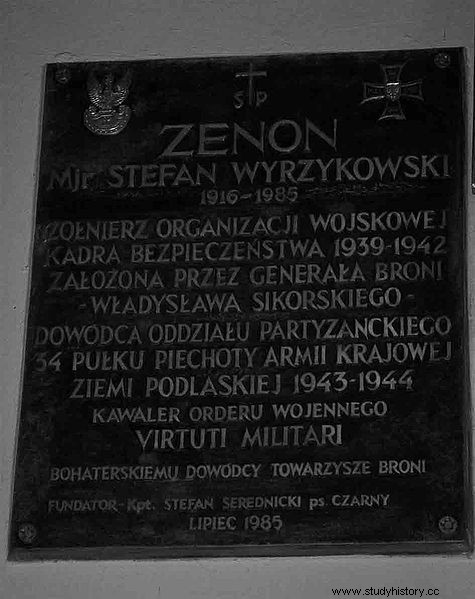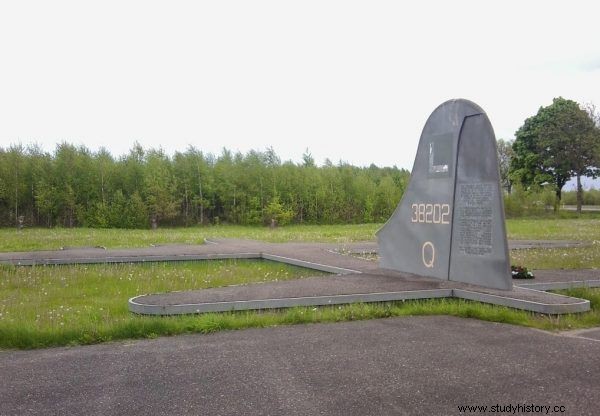Losing the Flying Fortress, sacrificial help from Poles, fighting with a unit of Polish partisans and breaking through to the Russian lines to finally return to their own. It took that much commitment to help the Americans shot down on the territory of occupied Poland.
On June 21, 1944, an American bomber crashed to the ground near the village of Woroniec in the Biała Podlaska commune. It was the Boeing B-17, known as the Flying Fortress. He belonged to. It took off from Norfolk airport in England. The plane belonged to a group of 112 machines that carried out an action under the code name "Frantic" (Raging). It consisted of a shuttle task - planes took off from England, bombed targets in Germany and landed on the territory of the USSR near Poltava.
This time the target was a synthetic fuel refinery in Ruhland, north of Dresden. After completing the task, the planes flew east. At the height of Międzyrzec Podlaski, the bomber formation was attacked by German Messerschmitt Me 109 fighters. One of them accurately fired a B-17 from a 20 mm cannon, which resulted in the shutdown of two engines and damage to the cockpit. The plane began to lose altitude rapidly, so the pilot gave the order to abandon the deck. The bomber crew consisted of 10 people. They all managed to parachute out despite the fact that two shooters were injured.
Alfred Lea
Lieutenant Alfred Lea, in the role of navigator, recalls the moment as follows:“I had great difficulty opening the emergency hatch on the plane. Finally succeeded!". Lea made a jump from 915 meters. The moment his parachute opened, he noticed his plane hitting the ground:
I landed in a wheat field about half a mile from the burning bomber. I started running towards him when suddenly I was stopped by a local host and his wife who thought I was Russian.
Lea also noticed his colleague landing nearby. A group of people gathered around them:"We could not understand what they were saying to us, so we headed towards the nearby village". The Poles detained the Americans, letting them know that it would be safer for them to hide in the crops. They took care of their parachutes and brought them water. The decision to hide in tall wheat turned out to be right as a truck filled with German soldiers suddenly appeared in the area.

B-17G under fire from anti-aircraft artillery. Illustrative photo
The Americans managed to find a few more friends, and then they followed one of the Poles. He took them to a farm where, as he assured, was to live a Polish partisan who spoke English well. On the spot, it turned out that his English was poor. He was well armed though, had Polish military maps, which might have meant he was a commander. The Americans understood that they had to follow him, but insisted that they should find the rest of their crew. A Pole who was trying to help them became angry because less than 150 meters from them was a truck with German soldiers. There was no time to argue:"He threatened to shoot us if we didn't listen to him, which in his mouth seemed like a pretty plausible threat."
They were on their way. They went to the main guerrilla base (who also turned out to be quite well-armed), and then to a neighboring village where, to their delight, Sergeant Herschell Wise, a sideline gunner, was waiting for them. He split his group:Lea and two other Americans left for another village in the evening, where they joined the other four of their crew.
Anthony Hutchinson
The flight technician, Sergeant Hutchinson, was on the upper deck when he heard the order to prepare for the jump. Having made sure that he had everything he needed, he suddenly lost his balance and collapsed. He only had time to check if everything was okay with his parachute line: "I noticed that, apart from the pilot who was about to disembark, there was no one left." Hutchinson rolled to the discharge port and was 240 meters above the ground and was able to exit the deck.
Almost immediately he tugged on the parachute line. The German Me 109 circled directly above it. Hutchinson managed to land safely on the field. Just as he began to retract his parachute, a man appeared with him. I said "American" to him and he replied "Comrade."
He then helped me deal with the parachute and all the rest of the equipment, and took me to his home, where there was hot food waiting for me on the table.
Hutchinson took out his card with the basic phrases and asked where the closest front line to the Russians was. They waved in such a way that I understood that the front is far beyond the horizon. "They made me understand that the Polish army was much closer and that they would take me to it." There was supposed to be someone who could speak English well. Lieutenant Hernandez also joined Hutchinson.
Louis R. Hernandez
Hernandez acted as a pilot. It was he who gave the order to prepare to disembark. He tried to keep the plane on a stable course while the co-pilot fitted him with a parachute. The plane turned a lot to the left side and it was very difficult to maintain a stable flight. As co-pilot Thomas Madden and flight technician Anthony Hutchinson jumped from the falling machine, Hernandez made a message to make sure no one was on board anymore.
I was just getting up from my seat when suddenly the plane jerked hard and I felt a shooting pain in my shoulder. I don't remember anything at all from the moment I pulled the parachute line to the moment when I was lying on my back in the field with people around me.
Hernandez was taken to one of the houses where he met Sergeant Hutchinson. They both received a meal and were hidden in a field. An hour later an interpreter came to them and hid them in a cart full of hay. Masked in this way, they were transported to a partisan camp. They made two stops to change cars, and during one such stop they were joined by Sergeant Gilbert, a sidekick. On the spot, the doctor gave them medical help, and the pilots were hidden in the barn. There he joined the rest of Madden, Lea, Baker and Wise.
At one point, a German patrol burst into the house where the Americans were. The airmen quickly split into groups and then hid in a wheat field.
We were lying in a field no more than 20 meters from a German tank that was firing at the village until dusk. We heard the Germans repeating the cries of "Americans". In the evening they withdrew. The nearby village was on fire.
Sergeant Wise, who was with Hernandez, concluded that their Polish guardians had to be killed. So they started their independent march to the east. At two o'clock in the morning someone shone a beam of light at them. For 15 minutes they stood as walled in order not to reveal their presence.
In the morning they went to the nearby farm, where they received water and the owner allowed them to stay in his barn. It is not known how the German appeared after only 20 minutes. Fortunately, he searched "half-heartedly" and found no flyers hidden under the hay. In the afternoon, the host hid the pilots on his cart and carried them through the forest to the partisans. There, after 24 hours, they met the rest of the crew they had parted with earlier.
Partisans of "Zeno"
The entire crew, consisting of 10 people, managed to jump out of the hit bomber. Three of them:Sergeant Jack White (radio operator), Sergeant William Cabaniss (round turret shooter) and Sergeant Arnold Shumate (rear gunner), fell into the hands of the Germans. The rest were looked after by the "Zeno" unit, which belonged to the 34th Infantry Regiment of the Home Army. Their commander was Major Stefan Wyrzykowski, pseudonym "Zenon". Already in December 1943, he became famous for the fact that he commanded the detachment covering the R-31 radio station of the Home Army Headquarters, which provided communication with the Polish government-in-exile in London.
When the group of people subordinated to Wyrzykowski grew, it was turned into, apart from a radio-telegraph platoon, a partisan unit of about 200 people.

Major Stefan Wyrzykowski ps. Zenon
On May 20, 1944, the unit of "Zeno" covered the operation in the vicinity of the village of Sarnaki. Its purpose was to recover the unexploded V2 rocket from the Bug River backwaters. The task of the people of "Zeno" was to organize offensive actions in the Mierzvice forests, about 10 kilometers from the place where the rocket was excavated. It was supposed to distract the Germans. Then parts of the rocket along with specially prepared documentation were sent to the Allies (action Bridge III).
Yet another time, "Zenon" showed excellent commanding skills when it came to a fight in the village of Jeziory. Thanks to the tactical maneuver, the "Zeno" unit inflicted losses on the Germans estimated at 120-190 people. He himself only lost two guerrillas.
Under the wings of "Zeno"
On the spot, the Americans met a translator and quartermaster registered in the American archives under the name of Leniovietz, Colonel Janczar and Major Muelier (spelling according to the American archives) - commander of the 35th Infantry Regiment. The partisans contacted the main Polish command in London via radio and sent the names, numbers and military ranks of the Americans. The Poles also informed the bomber's crew that Zenon managed to shoot five or six Germans in a skirmish in which a German tank took part. Later the Americans also found out that the man who offered them dinner paid a high price for it. The Germans killed him on the spot, his wife "only" knocked out his teeth and burned his farm to the ground.
Towards the Eastern Front
For the next three weeks, the guerrillas directed the Americans towards Brest, where the Russians were. On July 26, partisans tried to contact them from a village near Biała Podlaska, but came under fire from one of the German divisions. The Germans fired heavy machine guns against unarmed partisans. The situation was getting critical. When the attacking Germans almost managed to close the escape route of the Americans and Poles, the Russians came to the rescue. A small unit that had just been sent to "spy" on the German lines noticed what was happening and informed the command.

Memory board. Sanctuary in Leśna Podlaska
The Russian lieutenant, commanding a group of soldiers on the left wing, sent his man along with one of the Polish partisans to break through the German lines again and direct the artillery fire. The Russian artillery fired for three hours, which not only saved Poles and American airmen, but also allowed them to capture a large group of Germans.
The next night, the Americans and the partisans spent in the forest, just behind the Russian front line. Then the airmen were interrogated by a Russian lieutenant who sent their data, this time to the headquarters in Moscow.
Poles do not leave the Americans
The next day, the Americans were taken over by a Russian colonel. He transported them with two trucks to the field headquarters near Biała Podlaska. Both Zeno and the interpreter went with them. Zenon wanted to be absolutely sure that they would be taken under the proper care, and moreover: he demanded that the Russians provide him with a confirmation of handing over seven American pilots . He also insisted that the document should mention that the Poles placed them under the care of the Russians in good health.
The Poles accompanied the Americans on the way to the main command located eight miles south of Międzyrzecz. When they passed Międzyrzecz, the Americans found out that the remaining three of their crew fell into the hands of the Gestapo and died in a nearby hospital. Their bodies were buried by Poles living nearby. The Americans insisted that they wanted to go to their graves to identify the bodies, but the city was still under fire and the Russians refused to endanger them or themselves.
When they finally reached the headquarters, Zeno left them to return to his soldiers. He left an interpreter in his place, who went with them as far as Radzyń. There, after two days, they were taken over by a colonel of the Russian Air Force.

Monument to the American Airmen. Woroniec
On August 3, the Americans left Radzyń in a plane flown by the Russian captain Anatol Nathan Merzon. They landed in Chełm at night. Then they flew towards Poltava. There they met with the Russian general in command of the airport, who almost constantly asked if the Americans were treated properly by Russian soldiers.
The airmen were then questioned by Major General Welsh and his scout. Madden and Baker were taken by him to Moscow. The rest of the surviving flight crew traveled to Tehran on August 6 and then to Cairo, where Wise and Gilbert were hospitalized. Lea, Hernandez and Hutchinson continued their journey to Algiers and then to Casablanca, where they spent two days. Eventually, they were sent to Britain, where they finally arrived on August 12, 1944.
To this day, there is a memory of this event. On the E-30 road, near the town of Woroniec, there is the Monument of American Aviators, erected in 2000. It is a tribute to the group of 41,802 American airmen who sacrificed their lives carrying out a combat mission over European territory.
